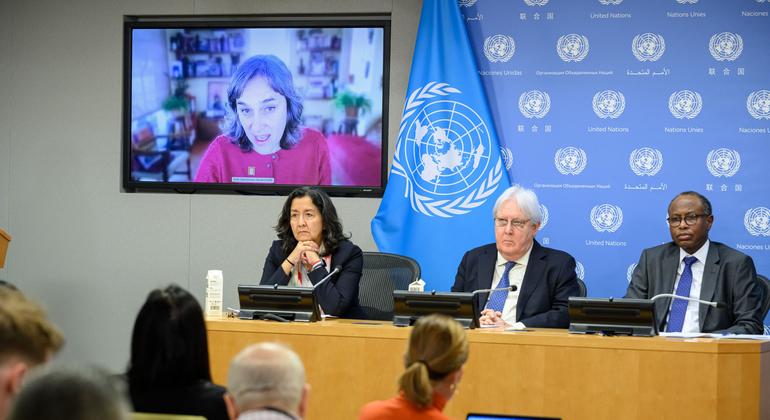Afghanistan: Humanitarians await guidelines on women’s role in aid operations

Representing the Inter-Agency Standing Committee (IASC), they stressed that the world’s largest humanitarian operation – supporting some 28 million people in Afghanistan – simply could not operate without women workers.
The officers reported on their mission to the country last week, following the order banning Afghan women from working with local and international aid agencies, announced in December 24.
Days later, the so true The Taliban authorities gave women permission to continue working in health.
A similar distinction is made in education, although the focus is on the primary level as Afghan girls and women are prevented from attending high school and university.
A clear message
In their meetings with the Taliban, the IASC mission expressed opposition to the ban, which they hoped would be lifted, and recommended exemptions in all human rights practices.
They were told that procedures are being developed, and they were asked to be patient, Martin Griffiths, UN relief chief and IASC chairman, spoke during a press conference at UN Headquarters.
“I’m someone who doesn’t like to comment too much, because it’s a matter of speculation. Let’s see if these directions are available. Let’s see if they are beneficial. Let’s see where there is a place for the importance and central role of women in our humanitarian work,” he said.
“Everybody has an opinion whether it will work or not. Our view is that the message has been made clear: that is Women are central, important workers in the humanitarian sectorin addition to having rights, and we need to see them back to work.”
Women’s special role
Humanitarians will need $4.6 billion to fund their operations in Afghanistan this year.
Three years of drought conditions, economic decline, and the effects of four decades of conflict, have left roughly two-thirds of the population, 28 million people, dependent on welfare, with six million on the verge of starvation.
Women make up 30 percent of the 55,000 Afghan nationals working for NGOs in the country, according to Janti Soeripto, President and CEO of Save the Children.
“Without women on our teams, we cannot provide humanitarian services to millions of children and women,” she said.
“We will not be able to identify their needs; communicating with female heads of families, of which there are many in Afghanistan after years and years of conflict, and to do so in a safe and traditional way.”
Live in danger
Furthermore, many women helpers are themselves breadwinners for their families, which means that many other families will be in need.
“We have made it clear that Humanitarian aid should not be conditional at allwe had cannot discriminate,” Ms. Soeripto said. “We are not there to do welfare politics. We cannot do this work without women in all parts of our value chains. ”
The loss of these valuable workers also comes as Afghanistan is facing its coldest winter in 15 years, with temperatures falling to nearly -30 degrees Celsius, causing many deaths.
The IASC mission visited a hospital outside the capital, Kabul, run by the United Nations Children’s Fund (UNICEF) and a local partner.
The job is back
Critical health and nutrition services are up and running again now that female staff are back on board, said Sofia Sprechmann Sineiro, Secretary General of CARE International.
The hospital staff also shared an alarming statistic, as 15 percent of the children who sought help were suffering from severe malnutrition.
“Therefore, let there be no negativity. Raise the hands of NGOs by preventing women from giving life-saving support to other women it will cost life” he said, speaking from Kabul.
During their meeting with the so true authorities, humanitarian leaders also push for the full inclusion of girls and women in public life.
Great learning loss
More than a million Afghan girls have missed out on education due to the order banning them from high school, which has added to the losses sustained during the COVID-19 pandemic.
The university ban, announced last month, has further crushed their hopes, said Omar Abdi, UNICEF’s Deputy Director for Programmes.
“We are very concerned about the development of girls and women and especially their mental health. In 2023, if secondary education is closed, an estimated 215,000 girls who attended sixth form last year will also be denied the right to study,” he said.
Despite the gloomy outlook, Mr. Abdi pointed to some positive signs.
Fast for hope
Since the ban, about 200,000 girls continue to attend secondary school in 12 provinces, and female secondary school teachers continue to receive their salaries.
“The representatives we met in Kabul … also assured that they are not against girls studying in high schools, and also promised to reopen once the guidelines are approved by the leadership them,” he said.
Meanwhile, the number of community-based education classes in private homes and other communities has doubled to 20,000 in the past year, serving some 600,000 children, more than half of whom are girls.
“These positive signs are the results of mutual commitment so true authorities and pressure from local communities to keep schools and local schools open,” said Mr. Abdi.
“As long as communities continue to demand education, we must continue to support public and alternative education methods, community-based classrooms, catch-up classes and job training.”







